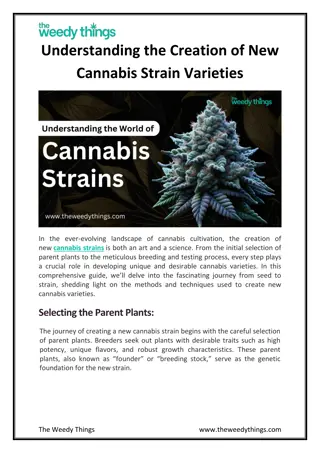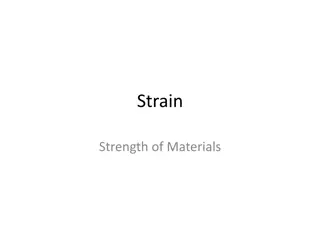Understanding True Stress and Strain in Materials
In materials engineering, the use of true stress and true strain provides a more accurate representation of material behavior, especially in regions undergoing deformation like necking. True stress considers the instantaneous cross-sectional area, accounting for changes in the material's strength during deformation. This concept aids in better analyzing stress-strain curves and understanding fracture mechanisms in ductile and brittle materials.
Download Presentation

Please find below an Image/Link to download the presentation.
The content on the website is provided AS IS for your information and personal use only. It may not be sold, licensed, or shared on other websites without obtaining consent from the author. Download presentation by click this link. If you encounter any issues during the download, it is possible that the publisher has removed the file from their server.
E N D
Presentation Transcript
True stress and True strain From fig 4 , the decline in the stress necessary to continue deformation past the maximum, point M, seems to indicate that the metal is becoming weaker. However, the cross-sectional area is decreasing rapidly within the neck region, where deformation is occurring. The stress, as computed from Equation 1, is on the basis of the original cross sectional area before any deformation, and does not take into account this reduction in area at the neck. Sometimes it is more meaningful to use a true stress true strain scheme. True stress is defined as the load F divided by the instantaneous cross-sectional area over which deformation is occurring (i.e., the neck, past the tensile point) Engineering strain = ?? ?? ?? where Li is actual length, Lo is gauge length ?? ?? True strain = ln ?? ?? ?? = Li T= ln ( E +1) Lo 1, so Li E = Lo = E + 1
Engineering stress E = F / Ao where Ao is original area True stress ( T) = F/ Ai , where Ai is the area where the fracture occurring at the necking region Since the volume is constant Ao L0 = Ai Li >>>>> Ai = [Li Lo ] / Ao Ao [Li F Lo ] T = F/ Ai = T = E ( E +1) For some metals and alloys, the region of the true stress/ strain curve up to M is approximated by: T = K T n Where K and n are constants depend on whether the material has been cold worked, heat treated, etc
Ductile and Brittle materials fracture Fracture: separation of a body into pieces due to stress, at temperatures below the melting point. Steps in fracture: 1- crack formation 2- crack propagation In ductile fracture, the crack grows at a slow pace and is accompanied with a great deal of plastic deformation due to the motion of dislocation. In this, the crack does not expand except when high levels of stress are present. Under the view of a microscope, the surfaces of materials with ductile fracture appear irregular and rough, and exhibit some dimpling Figure (12) Dislocations motion in ductile materials Figure (11) Steps of fracture for ductile materials
Brittle Fracture Very little or no plastic deformation, Crack propagation is very fast , Crack propagates nearly perpendicular to the direction of the applied stress, Crack often propagates by cleavage - breaking of atomic bonds along specific crystallographic planes (cleavage planes). Figure (12) difference in cracks for ductile and brittle materials Figure (13) Crack propagation in Brittle materials
Examples: 1. For a bronze alloy, the stress at which plastic deformation begins is 280 MPa, and the modulus of elasticity is 115 GPa. (a) What is the maximum load that may be applied to a specimen with a cross-sectional area of 325 mm2 without plastic deformation? (b)If the original specimen length is 120 mm, what is the maximum length to which it may be stretched without causing plastic deformation? Solution: (a) This portion of the problem calls for a determination of the maximum load that can be applied without plastic deformation (Fy). Taking the yield strength to be 280 MPa Fy = y Ao = (280 N/mm2 )(325 mm2 ) = 91000 N ? ? = Lo = /E = 280x106 / 115x109 = 0.00243 Ly-120mm = 0.00243 x 120mm Ly = 120.292 mm
Example #2: From the tensile stress strain behavior for the brass specimen shown in Figure below determine the following: (a) The modulus of elasticity (b) The yield strength at a strain offset of 0.002 (c) The maximum load that can be sustained by a cylindrical specimen having an original diameter of 12.8 mm (d) The change in length of a specimen originally 250 mm long that is subjected to a tensile stress of 345 MPa
a. E = slope = = = 2 1 2 1 Its easier if we take 1 and 1 as zero. For 2 = 150 MPa and 2 = 0.0016 , so E= 150 0 MPa 0.0016 0 = 93.8 GPa
(b) The 0.002 strain offset line is constructed as shown in the inset; its intersection with the stressstrain curve is at approximately 250 MPa which is the yield strength of the brass. ( c ) From the fig, the maximum tensile strength is 450 MPa Fmax = max(ult) Ao = max(ult) x ( r2) Fmax = ( 450 N/mm2 ) x ( (6.4 mm)2) F max = 57900 N (d) first necessary to determine the strain that is produced by a stress of 345 MPa. This is accomplished by locating the stress point on the stress strain curve, point A, and reading the corresponding strain from the strain axis, which is approximately 0.06. Inasmuch as Lo= 250 mm, we have l = Lo = 0.06 x 250 mm = 15mm.
Example 3: A cylindrical specimen of steel having an original diameter of 12.8 mm is tensile tested to fracture and found to have an engineering fracture strength of 460 MPa. If its cross-sectional diameter at fracture is 10.7 mm, determine: (a) The ductility in terms of percent reduction in area (b) The true stress at fracture (a) % RA= (Ao-Af / A0 ) x 100 %RA= { 12.8 2 (10.7/2)2 10.7 2 2 2} x 100 = 30% (b)True stress is defined the area is taken as the fracture area Af However, the load at fracture must first be computed from the fracture strength as F = f Ai = 460 MPa x [ (12.8/2 mm)2] = 59200 N f represents engineering stress E which is determined using the initial area T = F / Af T = 59200/ (10.7/2)2 T = 660 MPa
Example 4: A cylindrical specimen of aluminum having a diameter of 12.8 mm and a gauge length of 50.800 mm is pulled in tension. Use the load elongation characteristics shown in the following table to complete parts (a) through (e). Load Length N mm 0 50.800 7,330 50.851 15,100 50.902 23,100 50.952 30,400 51.003 34,400 51.054 38,400 51.308 41,300 51.816 44,800 52.832 46,200 53.848 47,300 54.864 47,500 55.880 46,100 56.896 44,800 57.658 42,600 58.420 (a) Plot the data as engineering stress versus engineering strain. (b) Compute the modulus of elasticity. (c) Determine the yield strength at a strain offset of 0.002. (d) Determine the tensile strength of this alloy. (e) What is the approximate ductility, in percent elongation? 36,400 59.1
(a) The data are plotted below on two plots: the first corresponds to the entire stressstrain curve, while for the second, the curve extends to just beyond the elastic region of deformation. = F/A When the load is 7330 N , so = F/ r2 = 7330 / (12.8/2)2 = 57 MPa At F= 15100 N , = 15100 / (12.8/2)2 = 117.4 MPa Then, we can do the same calculations for the resting loads to find their stresses = ? ?? , when F=0, so no change in length will be occurred ?=0 and =0 F= 7330, = 50.851 50.8 = 0.001 50.8 F= 15100, = 50.902 50.8 = 0.002 50.8 Then, we can do the same calculations for the resting loads to find their strain
(b) The elastic modulus is the slope in the linear elastic region E = 0.0032 0 = 200 ??? 0 ??? = 62.5 x103 MPa = 62.5 GPa (c) For the yield strength, the 0.002 strain offset line is drawn dashed. It intersects the stress strain curve at approximately 285 MPa. (d) The tensile strength is approximately 370 MPa, corresponding to the maximum stress on the complete stress-strain plot. (e) % EL= ?? ?? ?? x 100 = 59.1 50.8 x100 = 16.33 % 50.8
Example 5 : For some metal alloy, a true stress of 345 MPa produces a plastic true strain of 0.02. How much will a specimen of this material elongate when a true stress of 415 MPa is applied if the original length is 500 mm? Assume a value of 0.22 for the strain-hardening exponent, n. T = K ( T) n Next we must solve for the true strain produce when a true stress of 415 MPa is applied























